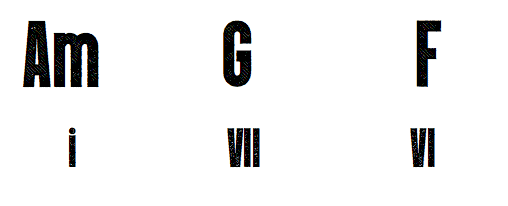In this lesson, we will be discovering 3 minor chord progressions to compose or practice chords with.
To build our 3 different minor chord progressions, we will use the degrees of the natural minor scale. Let’s use the A natural minor scale, which is C major’s relative minor scale. The relative minor of a major scale is its sixth degree. A is C major’s sixth degree. Just like the C major scale, the A natural minor scale has no sharp or flat in the key signature.
Diatonic Chords
Now that we know the notes of the A natural minor scale, it is time to build the triads that come from the different degrees of the scale. These triads can only contain notes that are in the A natural minor scale.
The Roman numerals of the natural minor scale are i, iib5, III, iv, v, VI, VII.

This means that the chord based on the first degree of the scale is minor. The chord based on the second degree is minor flat 5. The chord based on the third degree is major. The chords based on the fourth and fifth degrees are minor and the chords based on the sixth and seventh degrees are major.

Chord Progression #1: i-III-VI-VII
The first minor chord progression that we are learning is the “i-III-VI-VII”. In the A natural minor key, the chords of this progression are Am-C-F-G.

It is important to practice this progression in all inversions. By finding the closest voicing to go from one chord to another, inversions lead to a smoother playing.
Transposition
When working with Roman numerals as we do with our “i-III-VI-VII” movement, transposing our progressions in all keys is very beneficial for mastering major and minor chords.
Let’s transpose our “i-III-VI-VII” progression in the D minor key. The D natural minor key has a Bb at the key signature.

The chord associated with the first degree of the scale is Dm. The chord associated with the third degree is F. The chord associated with the sixth degree is Bb. Finally, the chord associated with the seventh degree is C. Therefore, in the key of D minor, the “i-III-VI-VII” progression is Dm-F-Bb-C.

Chord Progression #2: i-VII-VI
The second minor chord progression we are learning is the “i-VII-VI”. In the A natural minor scale, the chords of this progression are Am-G-F.
You should also practice this progression in all inversions and all keys.

Chord Progressions #3: i-VI-V-VII
The third chord progression that we are learning is the “i-VI-V-VII”. In the A natural minor key, the chords of this progression are Am-F-Em-G.

You can now use these three minor chord progressions to compose or to practice your chords. As mentioned earlier, the most beneficial way to practice these is by exploring the inversions and by transposing in all keys. Transposing chord progressions is a fun and concrete way to practice major and minor chords.
Text Transcription by Andreane Boucher

Founder of Online Rock Lessons, Marine is the keyboardist for Uncle Kracker, Corey Hart and Highway Hunters.
With over 20 years of experience in show business, Marine is launching the first Canadian Music School dedicated to rock and blues lovers.






Questions